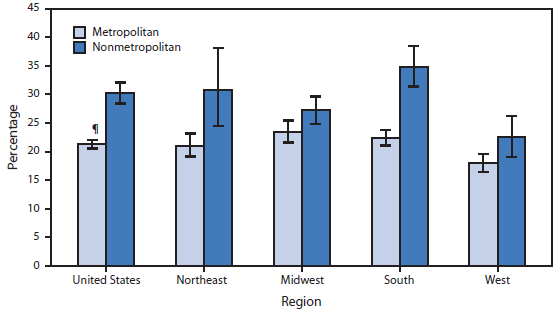QuickStats: Percentage of Adults Aged ≥65 Years Who Have Lost All Their Natural Teeth,* by Type of Locality† and Region — National Health Interview Survey, United States, 2010–2012§

* Based on response to the question, "Have you lost all of your upper and lower natural (permanent) teeth?"
† The designation of a place of residence as metropolitan or nonmetropolitan is determined by whether the household resides within a metropolitan statistical area, defined as a county or group of contiguous counties that contains at least one urbanized area of ≥50,000 population. Surrounding counties with strong economic ties to the urbanized area are also included. Nonmetropolitan areas do not include a large urbanized area and are generally thought of as more rural.
§ Estimates are based on household interviews of a sample of the civilian, noninstitutionalized U.S. population and are derived from the National Health Interview Survey sample adult component. Estimates are age-adjusted using the projected 2000 U.S. population as the standard population and three age groups: 65–74 years, 75–84 years, and ≥85 years.
¶ 95% confidence interval.
During 2010–2012, 30% of adults aged ≥65 years living in nonmetropolitan areas had no natural teeth, compared with 21% of those living in metropolitan areas. The percentage of adults aged ≥65 years with no natural teeth was higher in nonmetropolitan areas than in metropolitan areas in all regions of the United States. In both metropolitan and nonmetropolitan areas, the West had the lowest percentage of adults with no natural teeth.
Sources: National Health Interview Survey, 2010–2012. Available at http://www.cdc.gov/nchs/nhis.htm.
CDC. Health Data Interactive. Available at http://www.cdc.gov/nchs/hdi.htm.
Reported by: Ellen A. Kramarow, PhD, ekramarow@cdc.gov, 301-458-4325.
Alternate Text: The figure above shows the percentage of adults aged ≥65 years who have lost all their natural teeth, by type of locality and region, in the United States during 2010–2012. During 2010–2012, 30% of adults aged ≥65 years living in nonmetropolitan areas had no natural teeth, compared with 21% of those living in metropolitan areas. The percentage of adults aged ≥65 years with no natural teeth was higher in nonmetropolitan areas than in metropolitan areas in all regions of the United States. In both metropolitan and nonmetropolitan areas, the West had the lowest percentage of adults with no natural teeth.
Use of trade names and commercial sources is for identification only and does not imply endorsement by the U.S. Department of
Health and Human Services.
References to non-CDC sites on the Internet are
provided as a service to MMWR readers and do not constitute or imply
endorsement of these organizations or their programs by CDC or the U.S.
Department of Health and Human Services. CDC is not responsible for the content
of pages found at these sites. URL addresses listed in MMWR were current as of
the date of publication.
All MMWR HTML versions of articles are electronic conversions from typeset documents.
This conversion might result in character translation or format errors in the HTML version.
Users are referred to the electronic PDF version (http://www.cdc.gov/mmwr)
and/or the original MMWR paper copy for printable versions of official text, figures, and tables.
An original paper copy of this issue can be obtained from the Superintendent of Documents, U.S.
Government Printing Office (GPO), Washington, DC 20402-9371;
telephone: (202) 512-1800. Contact GPO for current prices.
**Questions or messages regarding errors in formatting should be addressed to
mmwrq@cdc.gov.
 ShareCompartir
ShareCompartir


